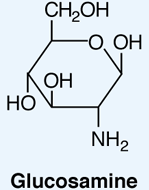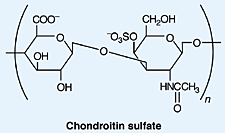
[Click on the images for questions about the compounds.]
Welcome to the murky and changing world of manufacturing glucosamine and chondroitin sulfate, ingredients in a popular over-the-counter osteoarthritis treatment. It would seem like a lucrative business, but low-priced and sometimes low-quality Chinese products have been making the going hard for established Western firms.
Glucosamine is a component of proteoglycan, one of the building blocks of human cartilage. Chondroitin is a polymer composed of alternating units of N-acetylglucosamine sulfate and glucuronic acid. Both compounds are found in and around the cells of the cartilage in people's joints.
On the theory that ingesting these compounds can help rebuild joints damaged
by osteoarthritis, synthetic glucosamine--as either its hydrochloride or sulfate
salt--and chondroitin sulfate have been formulated into some two dozen dietary
supplements intended to treat the ailment. 
Glucosamine -- The glucosamine manufacturing process arguably warrants some kind of quality control. The starting material is shells from crustaceans such as shrimp and crabs. Vanson , a Redmond, Wash., company buys, shells and dries, deproteinizes, and demineralizes them, leaving a compound known as chitin, or poly N-acetylglucosamine. The chitin is then deacylated to yield chitosan, or polyglucosamine, a compound formulated into a number of popular weight-loss products because of its ability to bind fats and oils. The Pfanstiehl company depolymerizes chitin and then deacetylates it to yield glucosamine.
Chondroitin -- Like glucosamine, chondroitin
comes from natural origins, in this case the cartilage of cows, and sometimes
pigs and sharks or bovine trachea which is otherwise sold to pet-food
makers. These are put in vessels, digested enzymatically, filtered, purified,
and then dried into a powder. The chemistry practiced in China is the same but
tends to be carried out by seafood processors that have jumped into the  glucosamine
business. Horror stories abound about how trachea are allowed to sit in the
sun outside Chinese chondroitin plants and be picked clean by vermin. Chondroitin
is a polymer of varying molecular weight for which no standard exists. The Chinese
product is generally backed by an unsigned certificate of analysis on a trading
firm's letterhead, making the results hard to confirm or query. Chinese chondroitin
is certified as 90% pure, but competitors allege that in reality it tests lower,
usually in the 80s, and sometimes as low as 20%.
glucosamine
business. Horror stories abound about how trachea are allowed to sit in the
sun outside Chinese chondroitin plants and be picked clean by vermin. Chondroitin
is a polymer of varying molecular weight for which no standard exists. The Chinese
product is generally backed by an unsigned certificate of analysis on a trading
firm's letterhead, making the results hard to confirm or query. Chinese chondroitin
is certified as 90% pure, but competitors allege that in reality it tests lower,
usually in the 80s, and sometimes as low as 20%.
So for the near future, buyers are advised to beware, because what is currently being sold as chondroitin sulfate in health food stores, drugstores, and mass merchandisers across the country could be just about anything.
ConsumerLab.com , an independent testing firm in White Plains, N.Y., recently analyzed 25 brands of glucosamine and chondroitin products to determine whether they contained the labeled amount of ingredients. All 10 of the glucosamine-only products passed. However, among combination chondroitin/glucosamine products, six out of 13 didn't pass, all because of low chondroitin levels. And neither of the two chondroitin-only products passed. Another lab tested 10 samples of chondroitin from various manufacturers that claimed to offer bovine-derived product. Most samples did pretty well, analyzing at 90% chondroitin or better. Two were in the mid-80s, and one came in at 16%. More disturbing, though, was the product origin determined by the testing: Five were bovine, two were porcine, and three were unidentifiable.
The Food and Drug Administration (FDA) has proposed regulations for dietary supplement ingredients to create standards for glucosamine.